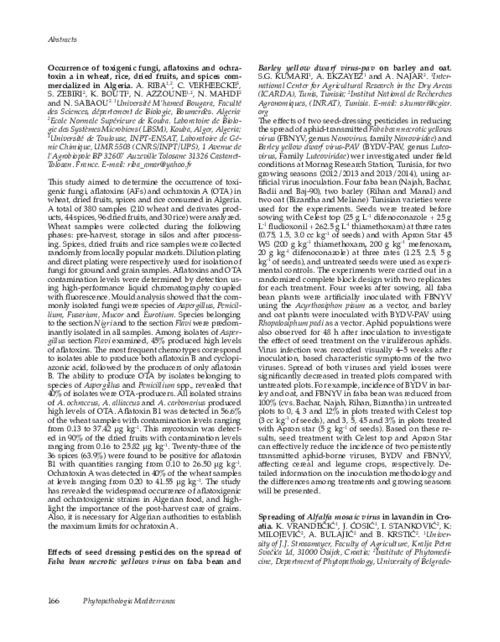Effects of seed dressing pesticides on the spread of Faba bean necrotic yellows virus on faba bean and Barley yellow dwarf virus-PAV on barley and oat
Abstract
The effects of two seed-dressing pesticides in reducing the spread of aphid-transmitted Faba bean necrotic yellows virus (FBNYV, genus Nanovirus, family Nanoviridae) and Barley yellow dwarf virus-PAV (BYDV-PAV, genus Luteovirus, Family Luteoviridae) wer investigated under field conditions at Mornag Research Station, Tunisia, for two growing seasons (2012/2013 and 2013/2014), using artificial virus inoculation. Four faba bean (Najah, Bachar, Badii and Baj-90), two barley (Rihan and Manal) and two oat (Bizantha and Meliane) Tunisian varieties were used for the experiments. Seeds were treated before sowing with Celest top (25 g L-1 difenoconazole + 25 g L-1 fludioxonil + 262.5 g L-1 thiamethoxam) at three rates (0.75, 1.5, 3.0 cc kg-1 of seeds) and with Apron Star 45 WS (200 g kg-1 thiamethoxam, 200 g kg-1 mefenoxam, 20 g kg-1 difenoconazole) at three rates (1.25, 2.5, 5 g kg-1 of seeds), and untreated seeds were used as experimental controls. The experiments were carried out in a randomized complete block design with two replicates for each treatment. Four weeks after sowing, all faba bean plants were artificially inoculated with FBNYV using the Acyrthosiphon pisum as a vector, and barley and oat plants were inoculated with BYDV-PAV using Rhopalosiphum padi as a vector. Aphid populations were also observed for 48 h after inoculation to investigate the effect of seed treatment on the viruliferous aphids. Virus infection was recorded visually 4‒5 weeks after inoculation, based characteristic symptoms of the two viruses. Spread of both viruses and yield losses were significantly decreased in treated plots compared with untreated plots. For example, incidence of BYDV in barley and oat, and FBNYV in faba bean was reduced from 100% (cvs. Bachar, Najah, Rihan, Bizantha) in untreated plots to 0, 4, 3 and 12% in plots treated with Celest top (3 cc kg-1 of seeds), and 3, 5, 45 and 3% in plots treated with Apron star (5 g kg-1 of seeds). Based on these results, seed treatment with Celest top and Apron Star can effectively reduce the incidence of two persistently transmitted aphid-borne viruses, BYDV and FBNYV, affecting cereal and legume crops, respectively. Detailed information on the inoculation methodology and the differences among treatments and growing seasons will be presented

